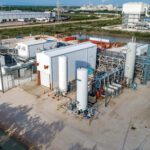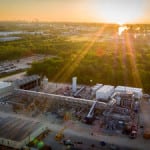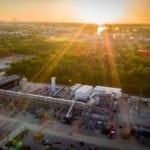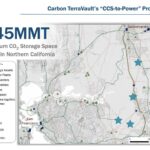NET Power, developer of the novel Allam-Fetvedt supercritical carbon dioxide (sCO2) power cycle, will build its first 300-MW natural gas–fired power plant at an Occidental-hosted site near Odessa, Texas.
The “serial number one” project will demonstrate—at utility scale—NET Power’s potentially revolutionary technology, which promises to provide low-cost gas-fired power generation, no atmospheric emissions, no water usage, and inherently captures all its carbon dioxide (CO2) emissions.
NET Power told POWER on Nov. 7 that the pioneering project in Odessa, which it chose “from a slate of early adopter project candidates,” will serve as a “commercial launch pad for NET Power’s core process technology, accelerating other projects already in development and providing the pathway for global deployment of this innovative decarbonization platform.”
The company has already completed Pre-Front End Engineering and Design (Pre-FEED) studies for the Odessa project. NET Power now plans to commence full FEED work in the first quarter of 2023. Construction is slated to begin in the third quarter of 2024, and NET Power anticipates that the utility-scale operation of the project could begin in 2026.
A Big Leap for the Much-Watched Allam Cycle
As POWER has reported in-depth, the Allam-Fetvedt Cycle (AFC) is essentially a specialized Brayton cycle in which the combustor is supplied with three flows: fuel gas, which is compressed in the fuel compressor; oxygen, which is produced in an air separation unit and then compressed; and a carbon dioxide working fluid that is heated in the multi-flow regenerator.
Combustion of this oxy-fuel mixture in the CO2 environment creates high-temperature products that then enter the carbon dioxide turbine. These products drive the power generator and then enter the multi-flow regenerator, where some of their heat is transferred to the heated flows. The flow is then directed to the cooler-separator, where its water and CO2 contents are split. Part of that CO2 is compressed to supercritical pressure, and the rest is sent to storage.
(For more, read POWER‘s explainer, “What Are Supercritical Carbon Dioxide Cycles?“]

According to industry estimates, the ACF’s reduced turbine size—achieved through its novel oxy-gas combustor—promises to provide improved cost-effective flexibility. NET Power’s projected efficiency for a natural gas–fired AFC plant with carbon capture and storage is up to 59% at lower heating value. Projected capital costs range from $900/kW to $1,200/kW. Costs for the Occidental project, however, will be determined at the conclusion of the FEED process, NET Power told POWER on Monday.
When completed, the Odessa project will combust natural gas and capture an estimated 860,000 tonnes of CO2 per year, NET Power said. The captured CO2 will then be transported to a permanent underground sequestration location through Occidental’s existing Permian CO2 handling infrastructure and operations.
NET Power said on Monday that it has so far engaged its strategic shareholders—Baker Hughes, Occidental, Constellation Energy, and 8 Rivers—to support the project. Occidental, a Houston-based international energy company, will spearhead CO2 transportation and sequestration, as well as power off-take. Constellation Energy Generation will support plant operations and also participate in power off-take.
Baker Hughes, a company that joined NET Power’s partnership in February 2022, will provide key integrated process equipment and technologies. Baker Hughes, notably, is in tandem developing and plans to market “a suite of integrated equipment and technologies, including supercritical CO2 turboexpanders.” 8 Rivers, a 2007-established investment startup that launched NET Power in 2010 to commercialize the AFC, said it would meanwhile continue to support project development support.
‘A Commercial Launchpad’
NET Power’s launch of its first official utility-scale project follows key milestones at its 50-MWth test facility in La Porte, Texas, including synchronization to the Texas electric grid in fall 2021. NET Power validated many first-of-a-kind components at the La Porte test facility, marking a substantial technology triumph in May 2018 when it achieved first fire of a novel commercial-scale 50-MWth combustor designed by Toshiba.
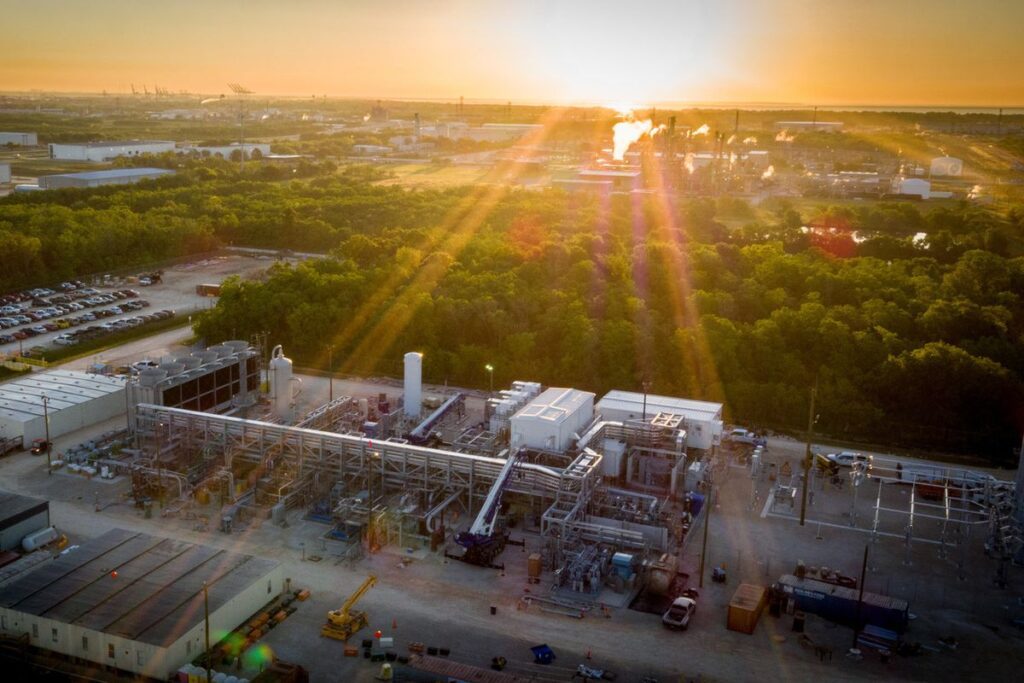
The company has since entered into a series of notable agreements that point to a potential pipeline of developing AFC projects. In April 2021, 8 Rivers unveiled plans for two 280-MW NET Power natural gas–fired plants in the U.S. These include the Coyote Clean Power Project in southwest Colorado, which will be located within the Southern Ute Indian Reservation, and the Broadwing Clean Energy Complex, which 8 Rivers is developing in partnership with agricultural and processing firm Archer-Daniels-Midlands Co. (ADM) at an existing CO2 storage facility site in Decatur, Illinois. When announced, the company suggested final investment decisions on the two projects were separately expected in 2022, and power production was expected in 2025.
In July 2021, Zero Degrees Whitetail Development Ltd. (ZDW), an 8 Rivers subsidiary, and Singapore-based Sembcorp subsidiary Sembcorp Energy UK said they would explore the development of the UK’s first 300-MW natural gas–fired NET Power station at an existing site at Teesside, northeastern England. While the companies did not provide a potential start date, 8 Rivers said the project may be the first of “multiple 300-MW facilities in the UK,” and that it could commission a NET Power station in the UK “as soon as 2025.”
And in August 2021, Frog Lake First Nation, the principal shareholder in Frog Lake Energy Resources Corp.—which is Canada’s leading indigenous-owned energy company—partnered with KANATA Clean Power and Climate Technologies to use NET Power’s patented technology to build a 300-MW plant. Frog Lake Nation suggested project development is underway, with construction expected to start in 2023 and power production to start by 2025.
According to NET Power, however, the newly announced Odessa project will lead its utility-scale demonstration efforts. A NET Power spokesperson told POWER on Monday that the company continues work “to advance its other early adopter projects to follow the plant announced [on Nov. 7].” No dates, however, are set for these other projects, he said. Asked about the status of these publicly announced projects, the spokesperson said they are ready to begin FEED studies. “We expect to sell multiple Development Licenses, the first step for our interested clients, in the near future,” he said.
“Several potential customers were interested in their project being NET Power’s utility-scale serial number 1. A joint commercial committee of NET Power and Baker Hughes conducted a rigorous evaluation to select the best candidate,” NET Power told POWER. “Factors considered included ability to standardize the plant design, risk sharing, financing confidence, [intellectual property] protection, and validation support. NET Power selected a consortium project it will lead, at an [Occidental]-hosted site, as the best balance of these factors, and to expedite the commercialization for the benefit of accelerating all downstream projects.”
Multiple Financing Routes
The Odessa project will be financed “through a combination of NET Power’s current capitalization program, investments from existing shareholders, and new project financing,” the company noted. NET Power, notably, also plans to pursue federal, state, and local government support “with a special focus on grant and loan opportunities arising from the Bipartisan Infrastructure Law.”
The company’s “long-term” opportunities may also leverage the Inflation Reduction Act and its enhancements to the 45Q carbon capture tax credit available to capturing facilities. “To qualify for these credits, electric generation units must be designed to capture at least 75% of carbon dioxide emissions, a number which NET Power facilities easily exceed,” the company said.
In addition to the benefits of the 45Q tax credit, NET Power is also looking at other grants and loan programs that will help move this project forward,” the company told POWER.
“Recent moves by the U.S. government to support clean, innovative, U.S.-grown technologies like NET Power unquestionably accelerate our commercialization plans. Grant and loan opportunities, as well as the 45Q tax credit enable our deployment,” it said.
—Sonal Patel is a POWER senior associate editor (@sonalcpatel, @POWERmagazine).







